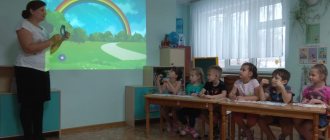Progress of educational activities
There is a knock on the door... Luntik arrives, holding a pot of flowers (dry leaves, withered flowers) in his hands.
Luntik. Guys, hello. I came to you for help. I found a wilted flower, and I don’t know how to help it, how to cure it. And I want to ask you for advice. Will you help me?
Educator. Guys, can we help Luntik? (Children's answers)
Educator. Let's tell him how we care for plants so that they grow well? (Children's answers)
Educator. Luntik, look, there are many flowers in our natural corner. Flowers that are in a room are called indoor plants. All indoor plants are blooming. And your flower's leaves have withered. How do you think why?
Luntik. He's probably sad.
Educator. Guys, why did the flower wilt? (Children's answers) Correct! Luntik, the flower wants to eat and drink.
Luntik. Like this? After all, he doesn’t have a mouth...
Educator. Plants do not have a mouth; they take water and nutrients from the ground through their roots. The roots carry water and nutrients into the stem, then into the leaves and the plant grows. Many plants bloom when they grow.
Demonstration of experience:
Dip the edge of a white cloth into a glass of colored water; the water begins to rise up the cloth.
Educator. And indoor plants love the sun, because it gives them light and warmth. And our kids love the sun too, don’t they? (Children's answers)
Physical exercise. The teacher reads a nursery rhyme with the children and performs movements according to the text
The sun looks through the window
It shines into our room.
We will clap our hands.
We are very happy about the sun.
Luntik. Wow, how interesting! The roots drink water and eat nutrients. Guys, do you drink and eat too? So that means you're growing too?
Lesson summary “Our indoor plants”
MKDOU Buturlinovsky kindergarten No. 11
Lesson summary for the preparatory group
"Our indoor plants"
(planting indoor plants)
Educator: Bolgova A.P.
Target:
Expand and systematize children's knowledge about indoor plants.
Tasks:
To consolidate knowledge about the structure of plants, about caring for them, about pests of indoor plants, about the vegetative propagation of indoor plants.
Cultivate an interest in caring for plants and a love for them.
Develop logical thinking, the ability to analyze, generalize using a visual and practical method - modeling.
Material:
Indoor plants, planting material, bowls with soil, sticks, watering can with water, oilcloths, aprons, cellophane, cards - models, game character - ladybug.
Preliminary work:
Conversations on “houseplant pests”, vegetative propagation of plants, preparation of planting material.
Progress of the lesson
Vos-l:
Guys, today a letter arrived at our kindergarten, look how big the envelope is! Our address is written on it. And it came from Dunno.
Guys, the letter is “alive”. Guess who hid in the envelope?
I'm asking a riddle
The back is red
There are black circles on it
There are three legs on each side.
who is this?
(children's answers)
Vos-l:
Right! Ladybug. What class of animals does the ladybug belong to?
(children's answers)
Vos-l:
hush, she's sleeping, don't wake her. Why is she sleeping?
(children's answers)
Vos-l:
In winter, the ladybug falls asleep. Like all insects, it hides under the bark of trees, in the cracks of houses, under pebbles.
Ladybug:
(wakes up) where am I?
Children:
Ladybug, you're in kindergarten.
Ladybug:
Hello children! My friend Dunno sent me to you. Listen to what he wrote (reads the letter).
"Dear Guys! I got into trouble. All my indoor plants began to die. I can't figure out why. I decided to write you a letter to your kindergarten. In the envelope with the letter I enclosed my assistant, as you already guessed who. You tell my ladybug how you can help me so that my plants begin to grow again. Sincerely, your old friend Dunno.”
Ladybug:
But trouble befell my green friends, houseplants. They have enemies.
Didactic game: “Friend or foe”
(children must identify pairs of two cards - name and image, and determine who is a friend of indoor plants and who is an enemy).
Ladybug:
Yes, I help control pests.
Vos-l:
At first glance, a ladybug seems like a harmless bug, but in reality it is a terrible predator! She busily runs along the branches and leaves, quickly moving her little legs in search of food. Its food is aphids, tiny but very harmful insects that suck the sap from plants. She has a good appetite, she can eat up to 200 aphids in a day, and her larva is even more voracious, and why is the Ladybug called that?
Lesson on the natural world in the preparatory school group “Houseplants and their care”
Transcript
1 MDOU “Kindergarten 101” Lesson on the natural world in the school preparatory group “Indoor plants and their care” Conducted by: teacher Bulanova M.A. g.o. Saransk 2017
2 Objectives: 1. Introduce children to indoor plants (ficus, violet, chlorophytum.) 2. Teach children to distinguish plants by appearance. 3. Improve skills in planting and caring for them. 4. Activate children's vocabulary. Visual materials and equipment: Indoor plants, pictures of flowers, watering can, cloth, wooden stick for loosening the soil, water, oilcloth, magnifying glass. Progress of the lesson: 1. Children sit on chairs. There are flowers on the tables in the group. — Today we will talk about indoor plants. (Knock on the door, the hero Dunno comes in) Dunno: - Hello guys, did I end up in a flower city? - Dunno. flowers grow not only in the garden, but also in the house. -Guys, explain to Dunno what flowers are called indoors. (Which grow at home, in the room). -Now we will tell Dunno about indoor plants. Telling riddles: A bush has grown in a tub And the leaf is wide and thick, like leather, Tightly folded, The elder trunk is like rubber
3 (ficus) - Dima S. will tell you about the ficus. - The large-leaved ficus is bush-like, reaching the height of a small tree. With very large leathery, shiny, green leaves. There is a pot on the window. It contains the most wonderful flower. Purple, elegant, alluring aromas. Children's answers (violet) - Arthur M. will tell you about the violet. The violet has a shortened stem. The leaves are oval or round, collected in a rosette. The violet blooms nine months a year. Does not require bright lighting or large pots. Green pod spiders hang from the mountain on cobwebs. Children's answers (chlorophytum) -Yaroslav S. will tell about chlorophytum. The birthplace of the flower is South Africa. The popular name is beard. It grows in both brightly lit and slightly shaded windows. It is undemanding to air humidity and temperature. -Now, together with Dunno, we will look at the violet. Touch the leaves. Trace them around the edge with your finger.
4 -What do the edges of the leaves look like? -Which violet leaves are smooth or fluffy? (The edges of the leaves look like a wave, the leaves feel fluffy to the touch) Now, through a magnifying glass, we will look at the hairs on the leaves of the violet. The hairs on violet leaves help retain moisture in the leaves. Violet leaves are collected in a rosette. Let's find these sockets. (Children examine the flower through a magnifying glass, pay attention to the rosettes.) The violet needs to be watered in a tray; the violet cannot be given a bath, since the drops left reflect the sun’s rays and burn the leaves. Physical education minute On the window in pots (squat down) Flowers rose (on their tiptoes, raising their arms up) Reached towards the sun (spread their arms out to the sides, palms up)
5 They smiled at the sun (turn to the right, hands on their belts to the left) Towards the sun the leaves (put their palms together above their heads) Turn the leaves (palms open the buds) Unfold the buds They will drown in the sun. -Indoor plants are green friends at home. -What are they for? (For beauty, comfort, aromatization, air purification.) - That's right, flowers really create coziness in a room, make the interior beautiful and attractive. -The most useful indoor plant is chlorophytum; within a day, chlorophytum kills almost all harmful bacteria and toxins accumulated in the room. - Dunno is wondering, what needs to be done to prevent the plants from dying? (Take care of them) -Let the guys tell and show Dunno how to care for plants. (You need to water the plants with water at room temperature, in summer the flowers are watered in the evening, and in winter in the morning. 1 child waters the flowers, a stick is needed to loosen the earth, 2 child loosens the earth,
6 leaves, a damp cloth is needed to wipe dust from large ones 3 the child takes a damp cloth and begins to wipe the leaves - Why do plants need soil? (Flowers are planted in it) -Why are indoor plants placed on the windowsill? (They need light to grow) -Why aren’t indoor plants taken outside in the fall and winter? (Plants need warmth)
7 -Why do they loosen the soil? (So that the plant can breathe) -Today, guys, we will plant a violet. Let's loosen the soil in the pot. Let's make a small indentation with a spatula. Place violet leaves. Let's water it and put it on the windowsill. (Children plant a flower and water it.)
8 E. Blaginina’s poem about indoor flowers will be read by Danila N. There’s a real garden on my window! Large Fuchsia earrings are hanging. A narrow date is climbing - The leaves are fresh. And the Russian palm tree has leaves like knives. A modest flame flared up with embers.
9 All under the hair of the Cactus is a stump. Tits are jumping under my window. The birds rejoice; it is pleasant for them. Look at this, Nice window. Where in winter there is summer, where there are a lot of flowers. Our lesson has come to an end. What did we do in class? (They guessed riddles, talked about flowers, learned how to properly care for indoor plants, planted a flower) - Let's always remember that these beautiful plants live next to us, grow, make us happy and need love and care. Dunno: -Guys, I had a lot of fun in your lesson. -I will definitely plant an indoor flower at home.
Educational tasks:
cultivate a desire to care for plants in a corner of nature.
Vocabulary work: earth, root, stem, leaf, flower, water, water, spray, wipe.
Preliminary work: examining indoor plants; working together to care for plants.
Equipment: indoor plant, a glass of colored water, a piece of white cloth, a watering can, a cloth for wiping leaves, a bowl of water.
Methods and techniques: conversation, explanations, instructions, story, surprise moment, game moment, productive activity.




